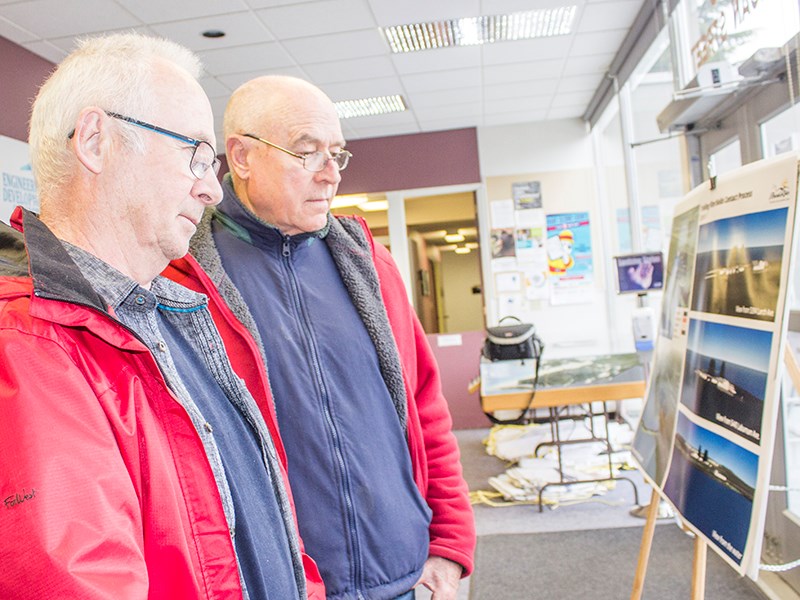Predesigns for City of Powell River’s future consolidated wastewater treatment facility are not sitting well with some Townsite residents who want to see a broader community discussion regarding waterfront development.
Members of PR Groundswell, a concerned residents group, were in attendance at a November 14 city committee of the whole meeting and voiced concerns about the treatment plant and the surrounding waterfront.
The wastewater facility will move into the final design stage in the new year after all major decisions regarding its model of treatment have been made. Three models under consideration for a 10-acre parcel of land include a trickling filter/solids contact facility, a high-efficiency biological treatment facility and an extended aeration facility.
Associated Engineering project manager Tom Robinson appeared before the committee to provide an update on three wastewater treatment options being examined for the future plant on Townsite’s waterfront; the company won the contract for the facility’s predesign last summer.
PR Groundswell organizer Ron Woznow said he has spoken to other members of the group and examined documentation provided by contracting engineers, and the consensus among members is the proposed options are not good enough.
"It appears as if they have taken a very traditional engineering approach to treating wastewater," said Woznow. "They haven't put it in the context of what makes sense for the long-term good of Powell River.”
PR Groundswell member Dave Wheatley said the designs seemed conventional and industrial looking, something area residents had also brought up with the engineering firm.
“We gave them very specific pictures, but we didn’t see any of that reflected in the designs,” said Wheatley. “They don't seem to be making an attempt at creating a modern facility.”
City councillor Rob Southcott said the group is asking the right questions about the future of Powell River.
“Where we are now is a point where we're starting to realize not just aesthetic, but economic value of the waterfront,” said Southcott. “Questions the Townsite group are asking are not questions that have been asked before in quite the way they are being asked right now.”
The footprint of each treatment plant model varies; the high-efficiency biological treatment facility has the smallest footprint of the three while the extended aeration facility has the largest, taking up almost all of the 10 acres.
Wheatley said he was a little surprised by the size of all the options, something he had previously expressed to Associated representatives.
"They are all very large," said Wheatley.
Mayor Dave Formosa was not at the predesign presentation but said it is still early in the process and the city will be looking for the public’s thoughts on each option. He added that he did not see any problem with how the predesigns looked.
“Right now it’s the vision of the engineers, not the community," he said.
Formosa said at this point he is more concerned with predesigns addressing odour control than appearance.
"I don't want anything that will smell,” said Formosa. “If we have to spend some more money and it's achievable to keep a lid on it, that’s what I'm going to support.”
Formosa said he can empathize with concerns of Townsite residents as the backyard deck of his house has a view of the future facility site.
"Whatever we do, we have to live with it for the next 100 years," said Formosa. “We have to do a good job of it.”
PR Groundswell member Grant Thomas said if the facility has to be located on the Townsite waterfront, the city should consider some beautification alternatives.
“They could look at burying the building or even half of it to make it less of an eyesore, place landscaping around it and definitely no chain-link fencing,” said Thomas.
Thomas and Wheatley agreed that designs should ensure the area is usable for other activities besides just wastewater treatment, which is the modern concept.
“That's forward thinking," added Wheatley, "all we saw was industrial design, nothing else.”
Formosa said issues such as the appearance of the facility should be brought up during the public-engagement process.
“We have to find a design we can all live with and afford,” said Formosa. “I'm wide open to looking at all these things.”
PR Groundswell member Doug Hudson said while the group has concerns about location and design of the facility, he remains optimistic that council will listen to the community.
“At least they are coming out talking to us," said Hudson. “It's much better than what we had before.”
Even though council may be more available, it may be missing an opportunity to take a broader look at the project and potential for smarter waterfront development, according to Groundswell members.
"The concern I have is what appears to be the lack of city council taking a longer term view of Powell River," said Woznow.
Woznow said his group has looked at how towns up and down the coast have approached revitalizing through waterfront development.
“You don't have to go very far to find a huge number of communities relocating industry to someplace more appropriate and reclaiming their waterfront as a real community resource,” he said.
Woznow added that the future wastewater treatment facility should be built in a way that does not diminish the charm of Townsite’s garden-city design.
“There is the status quo,” said Woznow, “and then there's creative thinking.”



